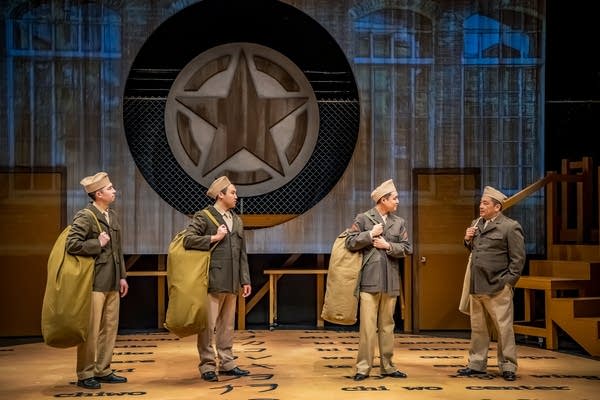‘Secret Warriors’ sheds light on Japanese American involvement in WWII

Go Deeper.
Create an account or log in to save stories.
Like this?
Thanks for liking this story! We have added it to a list of your favorite stories.
Across the jungles and inlets of the Pacific theater during World War II, a unit of Japanese American soldiers tests its abilities as translators. Their mission is to intercept and interpret enemy communications — while their families remain held in U.S. internment camps.
That tension is at the heart of Rick Shiomi’s new play, “Secret Warriors,” now at the History Theatre in St. Paul and directed by Lily Tung Crystal. Shiomi is known professionally as R.A. Shiomi.
“There’s no plays about these people. There’s no movies about these people, in a sense. And they played a very critical role in the Second World War,” Shiomi said.
During the war, Japanese Americans became targets of the U.S. government. In the wake of Pearl Harbor, thousands were forcibly removed from their homes, communities and businesses, and sent to internment camps. At the same time, some were drafted or volunteered to aid the U.S. war effort.
Turn Up Your Support
MPR News helps you turn down the noise and build shared understanding. Turn up your support for this public resource and keep trusted journalism accessible to all.
“Secret Warriors” looks at this moment in history. The play is filled with weighty historical information, occasionally lightened with moments of levity.
The play is historical fiction and follows Nisei soldiers, the American-born children of Japanese immigrants. Their service is legendary — the 442nd Regimental Combat Team, made up almost entirely of Nisei, became one of the most decorated units in U.S. military history.
General Charles Willoughby estimated that Nisei interpreters working in military intelligence helped shorten the war by about two years. But the impact of the Nisei wasn’t always known.
“I grew up in Toronto, far away from the west coast in the 50s and 60s, and so really, these stories did not come out until the 70s or 80s and beyond that,” Shiomi said.
Like in the United States, the Canadian government also interned people of Japanese ancestry during the war.
“My family was, in that sense, interned during the Second World War, and I barely knew anything about that growing up.”
Shiomi didn’t learn about the extent of Japanese Americans’ role in the Pacific theater until he moved to Minnesota, especially their work as interpreters and interrogators.

“In fact, the school [for interpreters] was based here in Minnesota.”
Camp Savage, the Minnesota-based interpreter school, is the setting for most of Act 1. Due to executive orders, Japanese Americans were barred from staying on the West Coast, and after other Midwest states refused to host the school, Minnesota was chosen.
Act 2 shifts between the soldiers overseas and their families back home.
The show doesn’t shy away from the racism Japanese Americans faced both on and off base. While writing the play, Shiomi kept asking what was going through the minds of soldiers serving a country that had turned its back on them.
“For some of them, I think it was really a form of patriotism. That they still believed in America. No matter how bad things were, they still believed in America,” Shiomi said.
“But there's also the element that they felt by serving, they would then create a record of patriotism, a record of success … and through that, after the war, would then be able to say ... ‘we've sacrificed, we served with honor and success. And how can you now say we're not full citizens of America?’”
Shiomi also referenced recent attempts to erase military contributions by people of color — including the temporary removal of WWII Navajo Code Talkers from the Pentagon’s website. That page has since been restored.
Working on “Secret Warriors” affirmed something Shiomi has long believed.
“It's a constant reminder that if we don't tell our own stories, other people are going to tell them for us,” Shiomi said.
“Secret Warriors” runs at the History Theatre through April 19.



